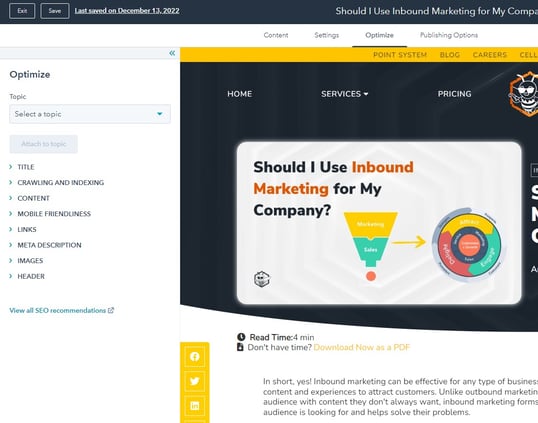As a marketer, you're probably already aware of how important it is to write your blogs with SEO in mind. I've spent time explaining how to choose a keyword, where to place that keyword in your blog, and how to make sure that you are doing everything necessary for Google (and other search engines...which exist...kind of) to know how to return your blog in its search results and help people find your business. But all of these steps can feel incredibly overwhelming! There's so much to remember and make sure you're doing correctly! How can you possibly be expected to get it right every time?
Enter the HubSpot SEO optimizer tool! Yes, I know I've been drilling into my love for HubSpot tools a lot lately, and this post is no exception. But I promise it's worth it. Because the tools that allow you to prioritize optimizing your blog post with HubSpot are incredible.
So let's talk about how HubSpot helps you to make sure your blog is optimized. It's an incredibly simple process. All you have to do is go into the software and start typing your blog. Once you've finished typing your blog, just click on the optimize icon in the toolbar on the left-hand side, and HubSpot provides you with a list of things you need to do in order to optimize your blog post! Let's take a look at an example:

You'll notice that in this particular blog post, the list of SEO items on the left-hand side has all green bullets next to it. That's because this post has been fully optimized for SEO and is ready to be posted. (Ok...this one is technically already posted, but it seemed like a good example anyway.) So not only does the HubSpot SEO optimizer give you a list of items that need to be addressed, it is actually smart enough to determine if that item has been completed and is ready for search engines to use.
HubSpot really takes all the difficulty out of ensuring that your content is search engine optimized and that visitors will be able to find you when they're searching your targeted keywords.
EXPERT TIP: In addition to using this tool on your blog posts, you can also use it on landing pages and website pages to make sure you're as SEO friendly as possible!
Looking for some other tips to make sure you're fully optimizing your blog posts? Check out our downloadable blog checklist today and get to writing.



.png?width=100&height=100&name=The%20Complete%20Guide%20to%20HubSpots%20Prospecting%20Agent%20(2025%20Edition).png)

.png?width=100&height=100&name=Why%20Were%20Not%20a%20Marketing%20Agency%20(And%20What%20That%20Means%20for%20Your%20Growth).png)